|
|
Post by Bonobo on Jan 30, 2016 14:27:55 GMT 1
Ancient Polish manuscript to be displayed
30.01.2016 13:39
A set of sermons believed to date back to the 13th or 14th century will be displayed at the National Library in Warsaw, on Saturday.
The Świętokrzyskie sermons.

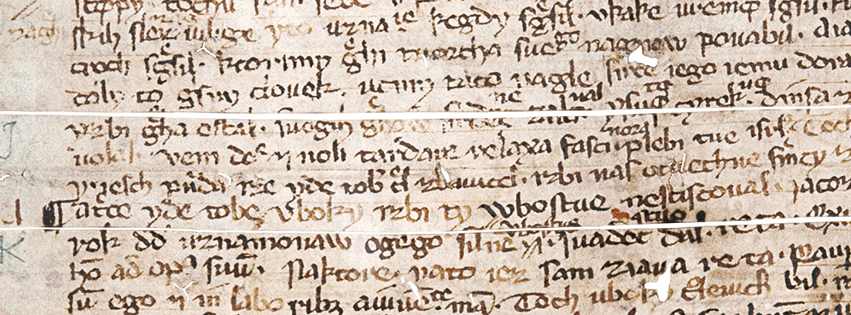
The Świętokrzyskie (‘Holy Cross’) sermons are regarded as the oldest pieces of prose writing in Polish.
“The Świętokrzyskie sermons are one of the most valuable manuscripts, […] a cultural relic,” the director of the National Library, Tomasz Makowski, said.
The manuscript is part of a exhibition that will display a cultural relic for a few hours once a month at the National Library.
The exhibition marks the 1,050th anniversary of the baptism of Mieszko I, the first Christian ruler of Poland, marking the beginning of the Christianisation of the nation.
The sermons are named after the monastery in south-central Poland where they were found, which is believed by some to house a small piece of wood from the cross on which Jesus Christ was crucified. (ua/rg)- See more at: www.thenews.pl/1/11/Artykul/238713,Ancient-Polish-manuscript-to-be-displayed#sthash.dxQZdAHX.dpuf
|
|
|
|
Post by pjotr on Jan 31, 2016 15:49:35 GMT 1
This is very interesting. I remember that at school I learned about the first Dutch written text that was found; Hebban olla vogala, an 11th-century text fragment written in Old Dutch. . It is roughly translated as: " Have all birds begun nests, except me and you - what are we waiting for?" (Modern Dutch: Zijn alle vogels nesten begonnen, behalve ik en jij. Waarop wachten we nu?) 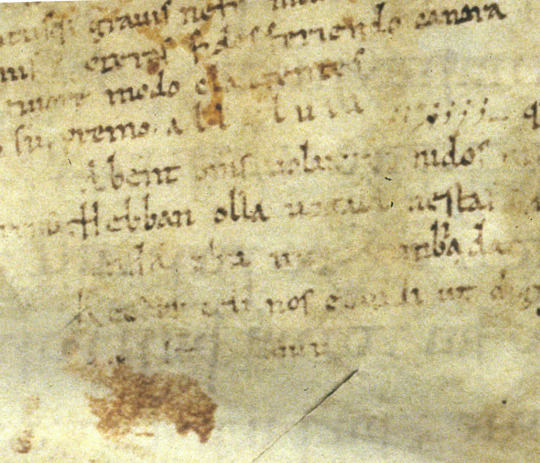 en.wikipedia.org/wiki/Hebban_olla_vogalaPolish language en.wikipedia.org/wiki/Hebban_olla_vogalaPolish language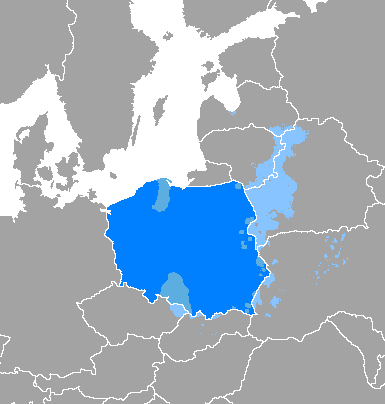 Polish language map Polish language mapThe originality of Polish culture is tied to its language and to its Slavonic roots. Linguistic studies indicate that 5000 to 4000 years ago early Balto-Slavic languages were part of the Aryan or the Eastern Indo-European languages. Over 3500 years ago, the languages of the Balto-Slavs separated from the Aryan languages; some 3000 years ago, the Baltic and Slavic languages separated from each other; and for the next 1500 years, the Slavic languages evolved parallel to the Greek, Latin, Celtic, Germanic, and other languages. The evolution of the Polish language occurred during the following 1500 years. Polish began to emerge around the 10th century, the process largely triggered by the establishment and development of the Polish state. Mieszko I, ruler of the Polans tribe from Greater Poland region, united a few culturally and linguistically related tribes from the basins of the Vistula and Odra before eventually accepting baptism in 966. With Christianity, Poland also adopted the Latin alphabet, which made it possible to write down Polish, until then existing only as a spoken language. The precursor to modern Polish is the Old Polish language. Ultimately, Polish is thought to descend from the unattested Proto-Slavic language. Polish was a lingua franca from 1500-1700 in small parts of Central and large portions of Eastern Europe, because of the political, cultural, scientific and military influence of the Polish-Lithuanian Commonwealth. Geographic distributionPoland is the most linguistically homogeneous European country; nearly 97% of Poland's citizens declare Polish as their native language. Elsewhere, ethnic Poles constitute large minorities in Lithuania, Belarus, and Ukraine. Polish is the most widely used minority language in Lithuania's Vilnius (Wilno) County (26% of the population, according to the 2001 census results, with Wilno (Vilnius) having been part of Poland until 1939) and is found elsewhere in southeastern Lithuania. In Ukraine it is most common in the western Lwów (Lviv) and Wołyń (Volyn) oblast (provinces), while in Western Belarus it is used by the significant Polish minority, especially in the Brest and Grodno regions and in areas along the Lithuanian border. There are significant numbers of Polish speakers among Polish emigrants and their descendants in many other countries. In the United States, Polish Americans number more than 11 million (See also: Polish language in the United States) but most of them cannot speak Polish fluently. According to the United States 2000 Census, 667,414 Americans of age five years and over reported Polish as the language spoken at home, which is about 1.4% of people who speak languages other than English, 0.25% of the US population, and 6% of the Polish-American population. The largest concentrations of Polish speakers reported in the census (over 50%) were found in three states: Illinois (185,749), New York (111,740), and New Jersey (74,663).[13] Enough people in these areas speak Polish that PNC Financial Services (which has a large number of branches and ATMs in all of these areas) offer ATM services available in Polish at all of their ATMs in addition to English and Spanish. According to the 2011 census there are now over 500,000 people in England and Wales who consider Polish to be their " main" language. In Canada, there is a significant Polish Canadian population: There are 242,885 speakers of Polish according to the 2006 census, with a particular concentration in Toronto (91,810 speakers) and Montreal. Source: Wikipedia |
|
|
|
Post by Bonobo on Jan 31, 2016 21:56:00 GMT 1
1 This is very interesting. I remember that at school I learned about the first Dutch written text that was found; Hebban olla vogala, an 11th-century text fragment written in Old Dutch. . It is roughly translated as: " Have all birds begun nests, except me and you - what are we waiting for?" 2 Poland is the most linguistically homogeneous European country; nearly 97% of Poland's citizens declare Polish as their native language. 1 Good. Who suggested it - male or female? 2 It again shows how closed society Poles live in. |
|
|
|
Post by pjotr on Jan 31, 2016 23:44:14 GMT 1
1 - The complete text, a probatio pennae or " scribble" by a monk to try out his pen, is usually transcribed as Hebban olla vogala nestas hagunnan hinase hic enda thu wat unbidan we nu. This is a word-for-word translation of the Latin sentence written directly above it: Abent omnes uolucres nidos inceptos nisi ego et tu quid expectamus nu(nc). It is roughly translated as: "Have all birds begun nests, except me and you - what are we waiting for?" (Modern Dutch: Zijn alle vogels nesten begonnen, behalve ik en jij. Waarop wachten we nu?) Comparison to Modern Dutch and Modern EnglishIn this comparison similar Modern Dutch and Modern English words (in form and meaning) are chosen to compare them with the Old Dutch equivalents in the sentence. The Dutch sentence is a correct one, although the verb 'begonnen' is usually conjugated with 'zijn' (be) and not with 'hebben' (have). For English the word order had to be adjusted. For 'hinase' and 'unbidan' there are no close matches in either language. OriginThe text is usually considered West Flemish; the arguments in favour of this view were advanced by Schönfeld (1933).[5] According to his interpretation, *agunnan, hinase and (as he read it) anda are Ingvaeonic forms whose presence might be expected in any of the coastal dialects of Old Frisian, Old Saxon or Old Frankish. However, the -n of third person plural hebban, which is absent in both Old English and Frisian, identifies the language as Old Dutch. (Old High German habent uses a different stem.) nestas is the plural of a masculine nest that is attested in Middle Dutch and is still present in West Flemish. vogala has an epenthetic vocal of a type also found in certain Old Ghentish words, whereas Old English has fuglas. The form olla is the result of a vowel shift a > o before ll that is thought to have occurred in West Flemish at a very early date, possibly before 900. Finally, hagunnan and hi(c) have a prothetic h; according to Schönfeld, this also points to West Flemish, in which the h is frequently dropped or (in the written language) added before vowels (cf. abent in the Latin version). Various theories Wall poem in a building of the Leiden University Wall poem in a building of the Leiden UniversityAccording to professor Luc de Grauwe (nl) of the University of Ghent, the text could equally well be Old English, more specifically Old Kentish. Recently, professor Frits van Oostrom of Utrecht University linked it to the Moorish Kharjas genre, which includes verses sung by women to their absent lovers. He concludes that the fragment was probably written by a woman or from a female perspective. 2 - You mean that Poland is so homogenic, that there is only one Polish, Roman-Catholic and one Polish language narrative? The Netherlands is diverse, because despite our national Netherlands Dutch identity many Dutch have regional and local identities, mixed backgrounds (one foreign parent) and experiances with mixed schools (Dutch and migrant children) and mixed neighbourhoods. An Amsterdam, Rotterdam, The Hague or Utrecht guy from the Randstad ( en.wikipedia.org/wiki/Randstad ) is completely different from a Frisian speaking Frisian, a Low Saxon regional language (Drents or Twents) Eastern-Dutch or a heavy Limburg dialect speaking Limburg person (who also happens to live in a far South-East corner inbetween Germany and Belgium, with heavy German and Belgian influences, and that's why Limburgian people often are seen by the arrogant people of the West or North as half Belgians or half Germans, and thus alien. Being mocked a lot, like Bavarians in Germany by other Germans from the North). The 431,000 Indo people (Europeans or Eurasian people) are also different, because they are often coloured and have asian looks. And next to that our Creole Surinamese, Hindustan Surinamese, Javanese-Surianamese, Chinese Surinamese and Dutch Antillian people. Poland is for 90 procent Roman-Catholic, and most Poles speak the same kind of Polish without a lot of Polish regional languages or dialects? Carribean summer carnaval in Rotterdam, the pride of the Dutch Antillian communtiySurinamese festival in Amsterdam, the festival for Black Dutch people, in the predominantly black Bijlmer neighbourhood in Amsterdam South-EastThis I filmed myself, Pasar Malam in the Zoo of Arnhem. Dutch Indo rock band which was very popular in the Netherlands and Germany in the late fifties and early sixties. They als played in Hamburg, Bremen, Düsseldorf and other German towns and for NATO troops (the Dutch army in Germany). They attracted large audiences. Dutch people and Germans liked these Indo guys. Kurd Newroz (New Year) celebrations in ArnhemWhen Turkey won from Czech republic in the World Championship in 2008 this happened in ArnhemMoluccan war dance in the colonial Dutch Indies army museum Bronbeek in Arnhem (One of the dancers was my Mensendieck: en.wikipedia.org/wiki/Mensendieck_system )
|
|
|
|
Post by Bonobo on Feb 18, 2016 23:15:45 GMT 1
Polish love letter almost 600 years old
14.02.2016 09:32
The oldest Polish love letter was written by Marcin from Międzyrzecz, western Poland, and is a testament to eternal love.
Andrzej Kirmiel, director of the regional museum in Międzyrzecz, shows a facsimile of the first love letter written in Polish.
The letter dates back to 1429 and was written by a resident of Międzyrzecz in western Poland.
It starts with the latin words “Ad dilectam”, which means “to beloved”, but the rest of the letter is written in Old-Polish language.
Marcin wrote the letter while on a trip to the Polish city of Poznań, where he was working as a secretary to the bishop.
Polish historians unanimously claim it is the oldest love letter ever written in Polish.- See more at: www.thenews.pl/1/11/Artykul/240658,Polish-love-letter-almost-600-years-old#sthash.Xb9BRHdP.dpuf 
|
|
|
|
Post by pjotr on Feb 19, 2016 1:04:11 GMT 1
Very interesting, and in the city I know, Poznan. Hermeneutics is interesting, Hermeneutics is the philosophy and methodology of text interpretation, especially the interpretation of biblical texts, wisdom literature, and philosophical texts.
|
|
|
|
Post by Bonobo on May 20, 2016 21:47:35 GMT 1
The Sankt Florian Psalter or Saint Florian Psalter (Latin: Psalterium florianense or Psalterium trilingue, German: Florianer Psalter or Florianspsalter, Polish: Psałterz floriański or Psałterz św. Jadwigi) is a brightly illuminated trilingual manuscript psalter, written between late 14th and early 15th centuries in Latin, Polish and German. The Polish text is the oldest known translation of the Book of Psalms into that language. Its author, first owners, and place of origin are still not certain. It was named after St. Florian Monastery in Sankt Florian, a town in Austria, where it was discovered
It is not known exactly who was original owner of the book. Most likely it belonged to a female member of the House of Anjou (wife or daughter of Louis I of Hungary), or it was made for Jadwiga of Poland.[1] Its creator is also unknown, and even its place of origin is uncertain, with scholars seeing either Silesia (Kłodzko) or Lesser Poland (Kraków) (or both) as the likely regions of origin.[2][3] The text contains several examples of central Lesser Poland dialect, and some scholars suggested that the work might have been carried out or at least influenced by bishop Piotr Wysz.[2][3]
Polish historian of literature, Julian Krzyżanowski, suggested that the text is a copy of an older work, perhaps the St. Kinga's Psalter (whose very existence is still disputed by scholars) though admitted that there's scant evidence for this.[3]
It was rediscovered by local librarian, Father Josef Chmel, in 1827 in St. Florian Monastery, in the town of Sankt Florian near Linz, Austria.[4] It first published in print in Vienna in 1834, by Polish publisher Stanislaw Jan Borkowski.[2] In 1931 the psalter was purchased by Polish government for the National Library of Poland.[2] During World War II it was evacuated to Romania and later to France and Canada, and returned to Poland in 1959.[2] By 1939, whole book was published in Lwow by Ludwik Biernacki.[2]
Currently, the book is kept at the National Library of Poland in Warsaw.
It is the oldest surviving translation of the Books of Psalms into the Polish language.[2][6] The translation from Latin into Polish, however, is considered very poor.[2] The psalter is also the oldest Polish language cultural artifact (zabytek) surviving to modern day in intact form.[7]   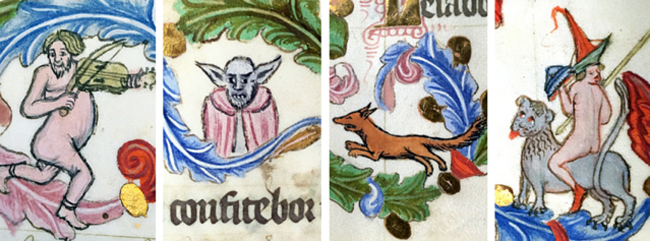 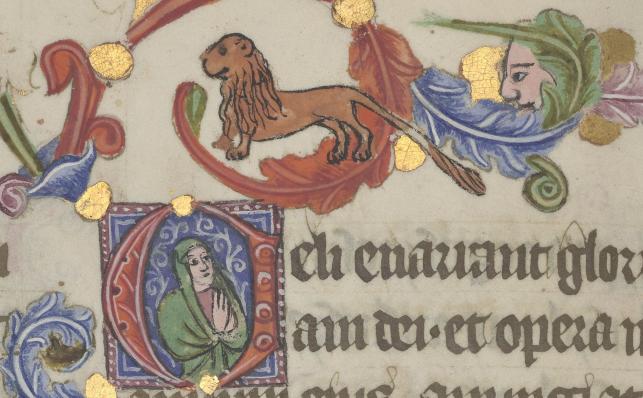 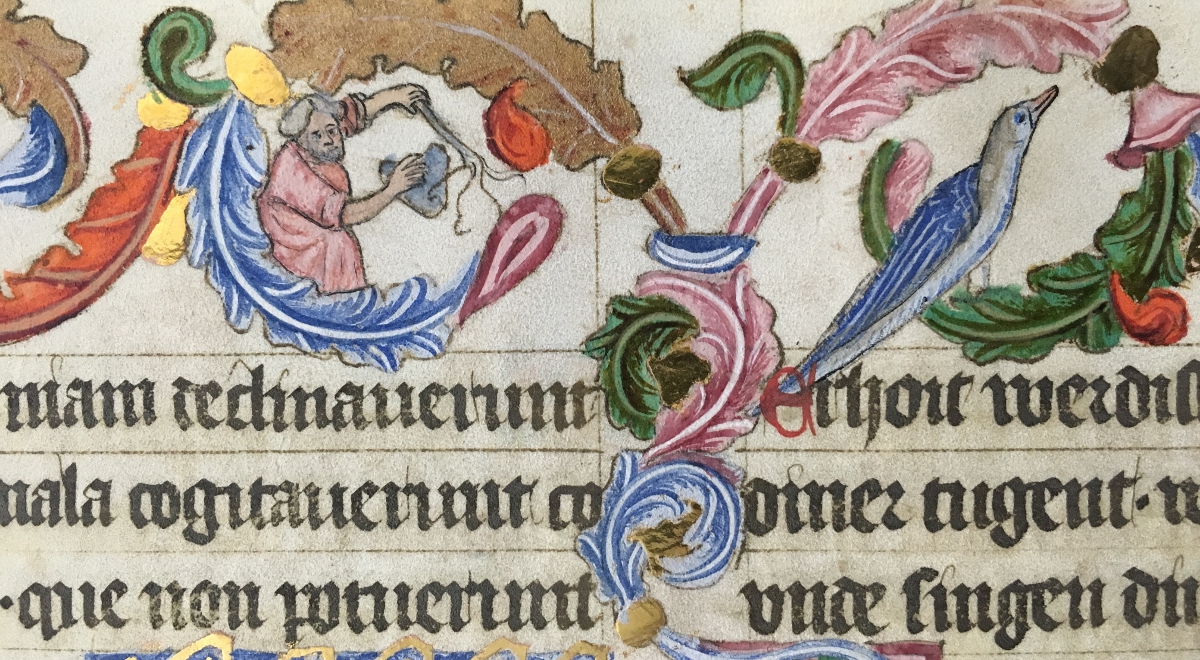 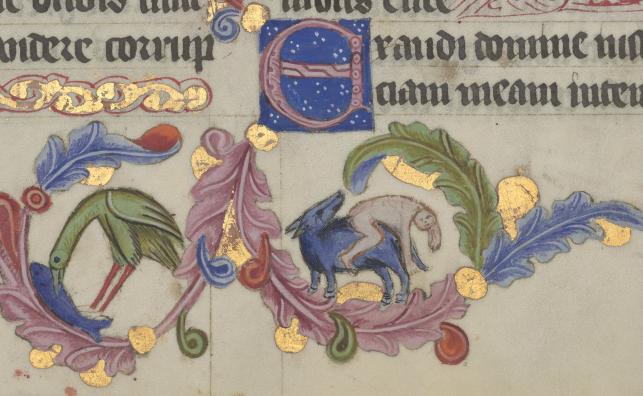  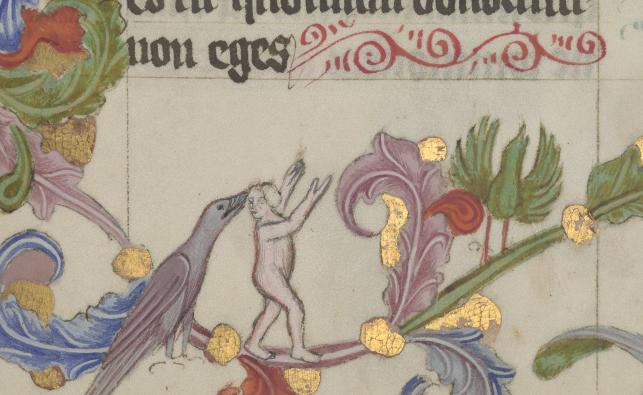 
|
|
|
|
Post by jeanne on May 20, 2016 22:51:07 GMT 1
Regardless of the quality of the language translation, the illustrations are amazing!It's so wonderful that it survived for us to see the incredible handiwork that went into such manuscripts!
|
|
|
|
Post by Bonobo on May 21, 2016 21:52:03 GMT 1
Regardless of the quality of the language translation, the illustrations are amazing!It's so wonderful that it survived for us to see the incredible handiwork that went into such manuscripts! Yes, those monks were very laborious. But also jokers, judging by some images. |
|
|
|
Post by jeanne on May 21, 2016 22:17:20 GMT 1
Regardless of the quality of the language translation, the illustrations are amazing!It's so wonderful that it survived for us to see the incredible handiwork that went into such manuscripts! Yes, those monks were very laborious. But also jokers, judging by some images. Agreed. They definitely don't fit the somber stereotype which of course is false anyway. |
|
|
|
Post by Bonobo on May 26, 2016 19:27:03 GMT 1
Latin language but Polish origin. The Banderia Prutenorum is a manuscript of 48 parchment sheets, 18.6 by 29.3 cm (7.3 by 11.5 inches), composed by Jan Długosz and illuminated by Stanisław Durink, listing 56 vexillae, or banners, of the Order of the Teutonic Knights. The title means Blazons of the Prussians.[1] Prutenorum is the genitive plural of Pruteni, Prussians.
In Polish the name is Chorągwie Pruskie. Chorągwie can mean banner, standard, or regiment. The heraldic term blazon in English is probably the exact meaning.
Historical circumstances of the Banderia
The work describes the gonfalons, or battle flags,[2] collected from the field after the Battle of Grunwald in 1410 AD. This battle was a major confrontation between the Teutonic Order and the allied forces of Poles and Lithuanians, whom the Order was trying to conquer. At that time, the Order had succeeded in subjecting or eliminating the western Balts, including the Prussians; however, the Teutonic Knights were decisively defeated by the joint forces of the Crown of the Kingdom of Poland and the Grand Duchy of Lithuania under the command of the Polish King Władysław II Jagiełło.
At the end of the battle, the major officers of the Order lay dead on the field beside the standards under which they had fought. Some units escaped with their standards. The Banderia does not describe all the order's flags. The flags were collected and stored at Wawel Cathedral in Cracow. They are known to have been there in 1603, after which they disappeared. They have been recreated, starting in the 1900. In October 2009, as part of the preparations for the battle's anniversairy, Polish scholars and artists in Kraków have finished reconstructing all known standards.[3]
Composition
It was probably the Polish historian, Jan Długosz, who commissioned the painter, Stanisław Durink of Cracow, to illustrate the flags in 1448. Długosz then wrote the Latin descriptions. The work thus has the format of a catalog, with an illumination and Latin entry for each flag.
The flag is decorated with a heraldic blazon identifying the comturia, or district, from which the soldiers of that unit came. The blazon might appear in any circumstances, such as in a coat of arms or on a shield, or in any conspicuous place. Its function was that of identification. The rules of heraldry were undoubtedly followed.
The title raises a few questions of language and society. In it a Polish scholar and historian is calling the conquerors of the Prussians by that very name, even though at the beginning of their conquest they found the name odious to them. Old Prussian speakers still lived in substantial numbers in east Prussia. As they were not excluded from military service, some must have fought for the order, and yet they are not distinguished from the Germans in any way.
Banderium is in origin neither Latin nor Polish, but comes from the Germanic. The place names also are in their Germanic forms rather than their Polish ones. Why Długosz, a Polish historian, chose to use the Germanicized Prussian Latin is not clear.
Location of the manuscript
By some miracle, the manuscript survived World War II, even though it was given to Malbork castle by the Nazis for political purposes. After the war it showed up at a London auction house and was brought to its current location in the library of Jagiellonian University.
Notes on the work
In the scholarly Latin of manuscript terminology, a recto page is "on the right side". The verso or "turned side" (the other side of the page) is therefore a left-hand page. This terminology has nothing to do with Długosz.
Durink states the width (latitudo) and length (longitudo) of each flag in units he calls ulne (classical ulnae). These must be cubits rather than ells; i.e., one ulna is 18 inches by today's standard ell. The flags are generally longer than they are wide.
Page 1 recto bears the following introduction:
Pro libraria universitatis studii Cracouiensis datum per dominum Johannem Dlugosch. Descriptio Prutenicae cladis seu crucigerorum sub Jagellone per Joannem Dlugosz canonicum Cracoviensem. Banderia Prutenorum anno domini millesimo quadringentesimo decimo in festo Divisionis Apostolorum erecta contra Polonie regem Wladislaum Jagyelno et per eundem regem prostrata et Cracouiam adducta ac in ecclesia catedrali suspensa, que, ut sequitur, in hune modum fuerunt depicta.
A translation directly from the Latin is:
"Given to the library of the university of study of Cracow by the master John Długosz. Description of the Prussian ruin or (the ruin) of the cross-bearers through Jagiello by John Dlugosz, canon of Cracow. The blazons of the Prussians in the year of the Lord 1410 in the holiday of the Divisio Apostolorum (Dispersal of the Apostles), which were erected against the king of Poland, Wladislaw Jagiello, and were cast down by the same king and brought to Cracow and hung in the church cathedral, were depicted in this manner, as follows."
The description to which Długosz refers is contained in the Latin notes with the flags.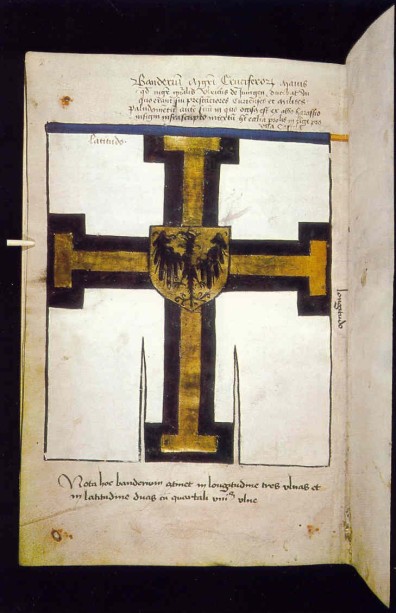 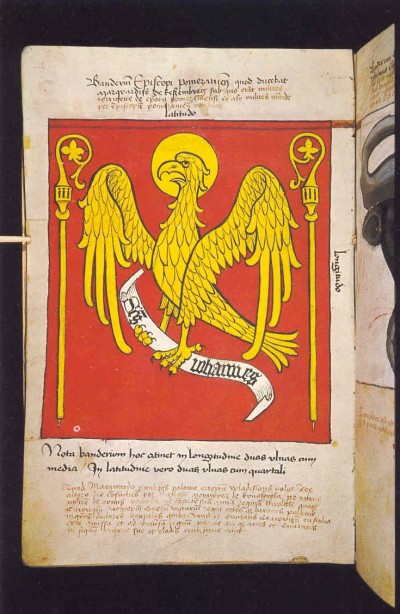  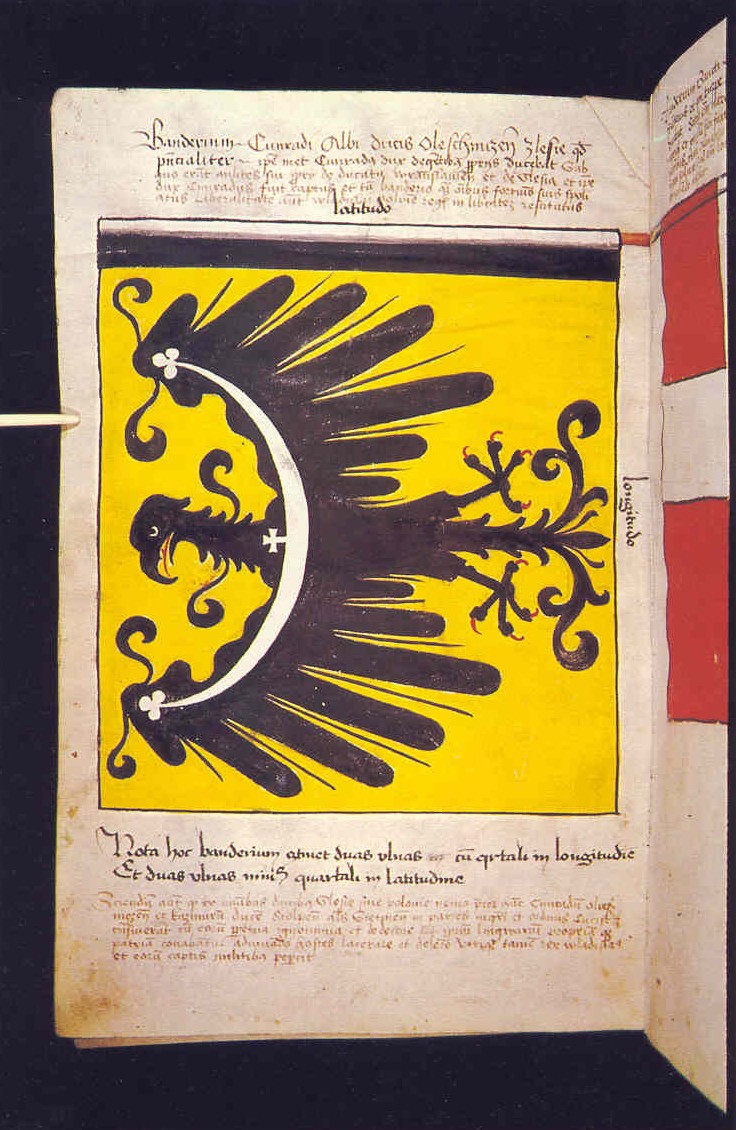 More sosreb.wordpress.com/2012/07/14/banderia-prutenorum/ All flags: pl.wikipedia.org/wiki/Banderia_Prutenorum |
|